Abandon Sustaining Innovation and Pursue Disruptive Innovation in Management
VerifiedAdded on 2023/04/24
|6
|1082
|215
AI Summary
This article discusses the importance of disruptive innovation over sustaining innovation in the field of management. It includes a case study and references to support the argument.
Contribute Materials
Your contribution can guide someone’s learning journey. Share your
documents today.
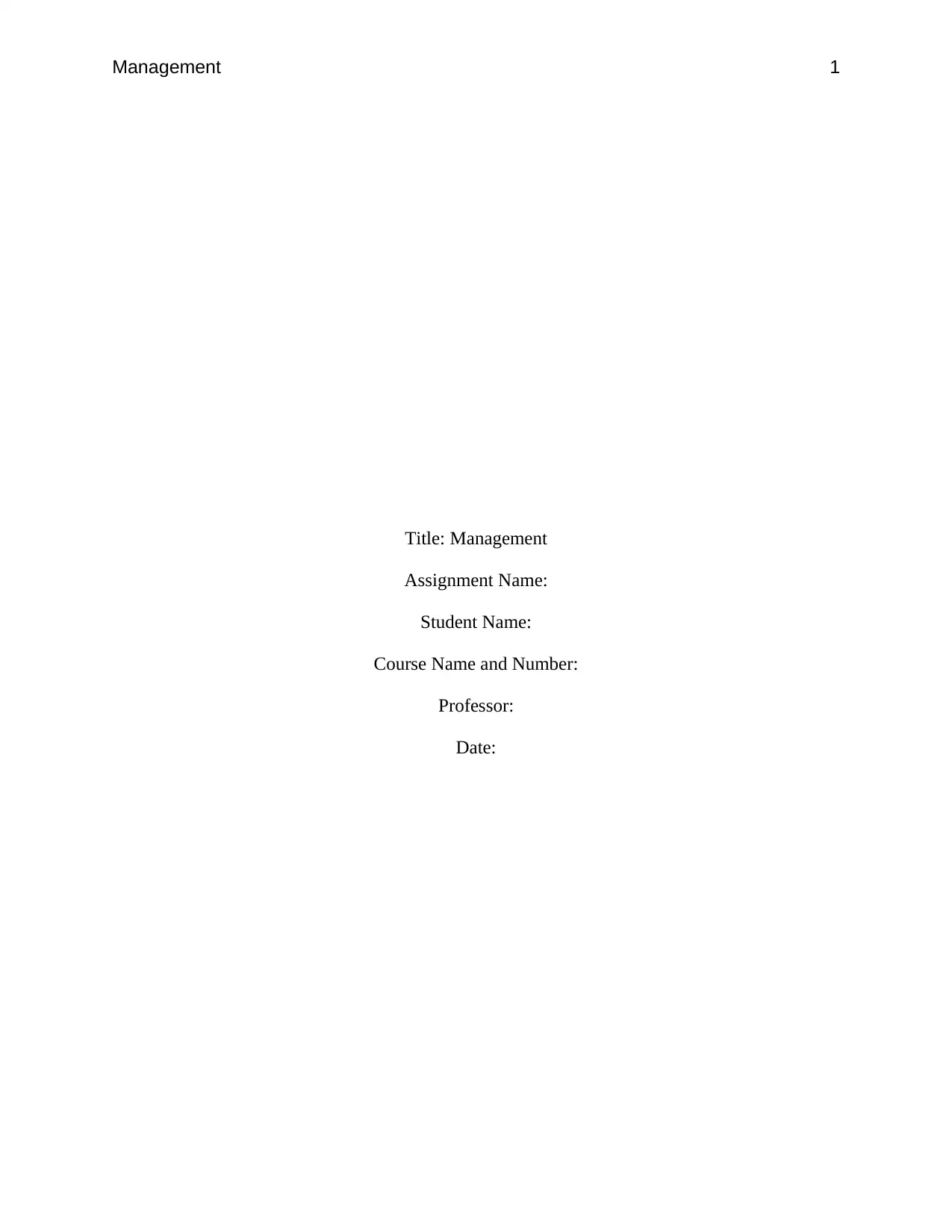
Management 1
Title: Management
Assignment Name:
Student Name:
Course Name and Number:
Professor:
Date:
Title: Management
Assignment Name:
Student Name:
Course Name and Number:
Professor:
Date:
Secure Best Marks with AI Grader
Need help grading? Try our AI Grader for instant feedback on your assignments.
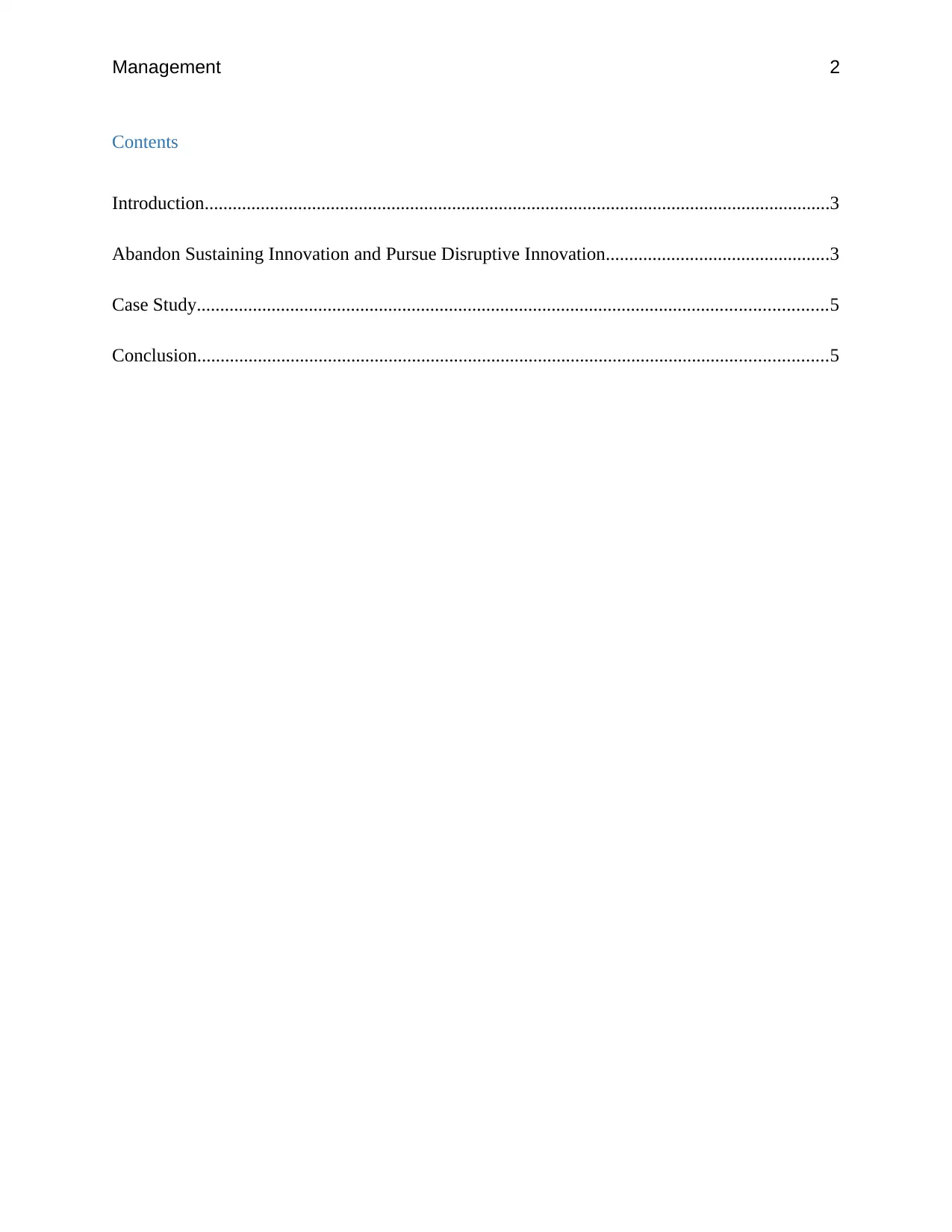
Management 2
Contents
Introduction......................................................................................................................................3
Abandon Sustaining Innovation and Pursue Disruptive Innovation................................................3
Case Study.......................................................................................................................................5
Conclusion.......................................................................................................................................5
Contents
Introduction......................................................................................................................................3
Abandon Sustaining Innovation and Pursue Disruptive Innovation................................................3
Case Study.......................................................................................................................................5
Conclusion.......................................................................................................................................5

Management 3
Introduction
Innovation is considered to be one of the most prominent factors in terms of calculating
the economy as it has a severe effect on the businesses and their model. The sustaining
innovation makes the competition really tough, in order to secure a position in the market. So,
the disruptive innovation helps to generate a challenge to their competitors as it disrupts the
current market and create a new valuable market. Undoubtedly, disruptive innovation has more
potential for the market growth as compared to the sustainable innovation. Various startups are
making their model which is dependent on the disruptive innovation in order to achieve
maximum profit rates and make a valuable impact in this competitive world.
Abandon Sustaining Innovation and Pursue Disruptive Innovation
According to Schumpeter 1994, the involvement of new startups play an important role in
order to check out on the economic growth as well as progress in terms of the technology. The
startups lead by the innovation of the new technologies and concept in the real world. These
innovations might turn out to be a failure at initial stages but they have tremendous market
opportunities (Denning, 2012).
The sustaining innovation has the power to target the customers which are demanding for
the same product, but has better performance and new features than the last product. These
innovations are launched after every year and it makes easy for the existing competitors in the
market (Lindsay & Hopkins, 2010). Building up the sustaining innovation are helping the
companies achieve higher profits as they can sell their newly inbuilt features to their current
consumers.
Introduction
Innovation is considered to be one of the most prominent factors in terms of calculating
the economy as it has a severe effect on the businesses and their model. The sustaining
innovation makes the competition really tough, in order to secure a position in the market. So,
the disruptive innovation helps to generate a challenge to their competitors as it disrupts the
current market and create a new valuable market. Undoubtedly, disruptive innovation has more
potential for the market growth as compared to the sustainable innovation. Various startups are
making their model which is dependent on the disruptive innovation in order to achieve
maximum profit rates and make a valuable impact in this competitive world.
Abandon Sustaining Innovation and Pursue Disruptive Innovation
According to Schumpeter 1994, the involvement of new startups play an important role in
order to check out on the economic growth as well as progress in terms of the technology. The
startups lead by the innovation of the new technologies and concept in the real world. These
innovations might turn out to be a failure at initial stages but they have tremendous market
opportunities (Denning, 2012).
The sustaining innovation has the power to target the customers which are demanding for
the same product, but has better performance and new features than the last product. These
innovations are launched after every year and it makes easy for the existing competitors in the
market (Lindsay & Hopkins, 2010). Building up the sustaining innovation are helping the
companies achieve higher profits as they can sell their newly inbuilt features to their current
consumers.
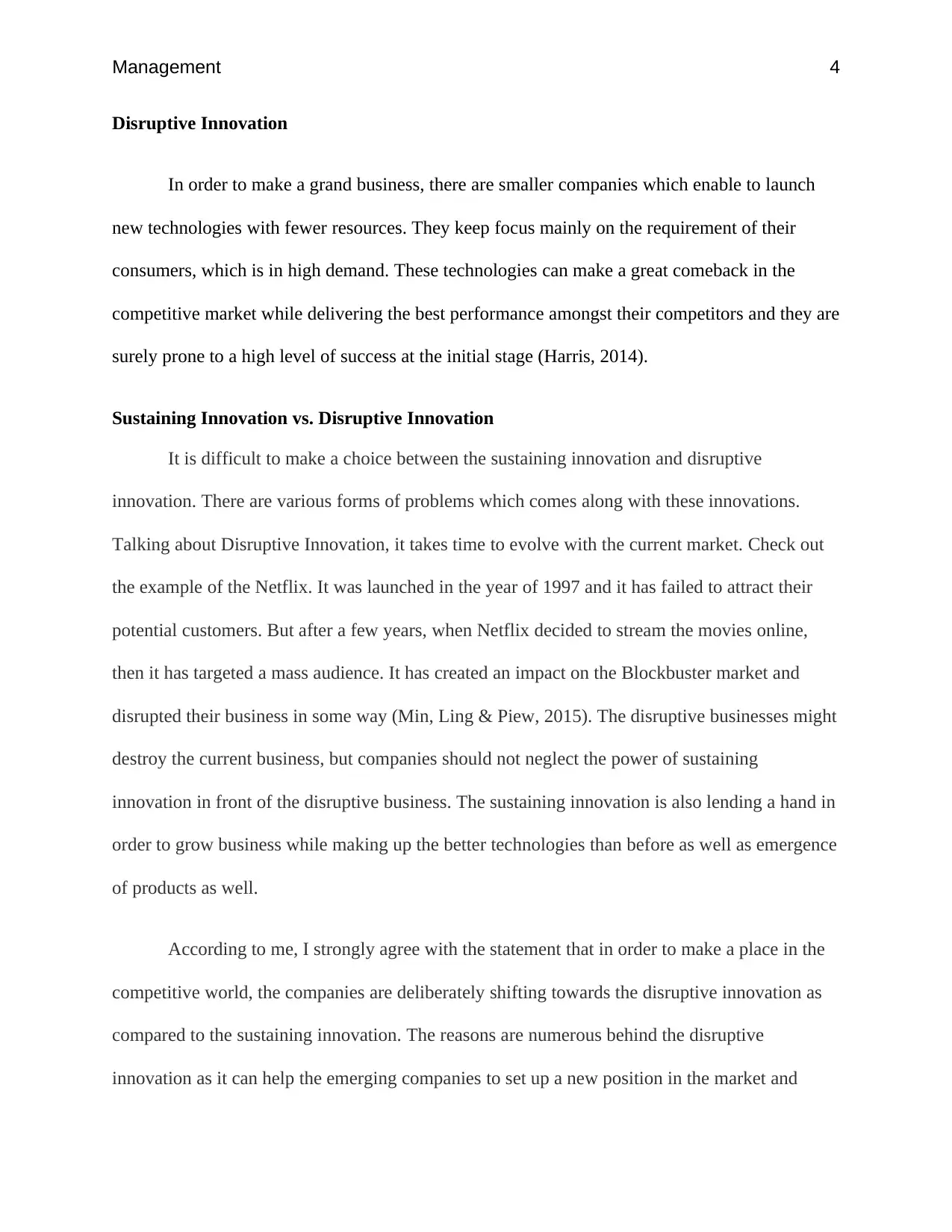
Management 4
Disruptive Innovation
In order to make a grand business, there are smaller companies which enable to launch
new technologies with fewer resources. They keep focus mainly on the requirement of their
consumers, which is in high demand. These technologies can make a great comeback in the
competitive market while delivering the best performance amongst their competitors and they are
surely prone to a high level of success at the initial stage (Harris, 2014).
Sustaining Innovation vs. Disruptive Innovation
It is difficult to make a choice between the sustaining innovation and disruptive
innovation. There are various forms of problems which comes along with these innovations.
Talking about Disruptive Innovation, it takes time to evolve with the current market. Check out
the example of the Netflix. It was launched in the year of 1997 and it has failed to attract their
potential customers. But after a few years, when Netflix decided to stream the movies online,
then it has targeted a mass audience. It has created an impact on the Blockbuster market and
disrupted their business in some way (Min, Ling & Piew, 2015). The disruptive businesses might
destroy the current business, but companies should not neglect the power of sustaining
innovation in front of the disruptive business. The sustaining innovation is also lending a hand in
order to grow business while making up the better technologies than before as well as emergence
of products as well.
According to me, I strongly agree with the statement that in order to make a place in the
competitive world, the companies are deliberately shifting towards the disruptive innovation as
compared to the sustaining innovation. The reasons are numerous behind the disruptive
innovation as it can help the emerging companies to set up a new position in the market and
Disruptive Innovation
In order to make a grand business, there are smaller companies which enable to launch
new technologies with fewer resources. They keep focus mainly on the requirement of their
consumers, which is in high demand. These technologies can make a great comeback in the
competitive market while delivering the best performance amongst their competitors and they are
surely prone to a high level of success at the initial stage (Harris, 2014).
Sustaining Innovation vs. Disruptive Innovation
It is difficult to make a choice between the sustaining innovation and disruptive
innovation. There are various forms of problems which comes along with these innovations.
Talking about Disruptive Innovation, it takes time to evolve with the current market. Check out
the example of the Netflix. It was launched in the year of 1997 and it has failed to attract their
potential customers. But after a few years, when Netflix decided to stream the movies online,
then it has targeted a mass audience. It has created an impact on the Blockbuster market and
disrupted their business in some way (Min, Ling & Piew, 2015). The disruptive businesses might
destroy the current business, but companies should not neglect the power of sustaining
innovation in front of the disruptive business. The sustaining innovation is also lending a hand in
order to grow business while making up the better technologies than before as well as emergence
of products as well.
According to me, I strongly agree with the statement that in order to make a place in the
competitive world, the companies are deliberately shifting towards the disruptive innovation as
compared to the sustaining innovation. The reasons are numerous behind the disruptive
innovation as it can help the emerging companies to set up a new position in the market and
Secure Best Marks with AI Grader
Need help grading? Try our AI Grader for instant feedback on your assignments.
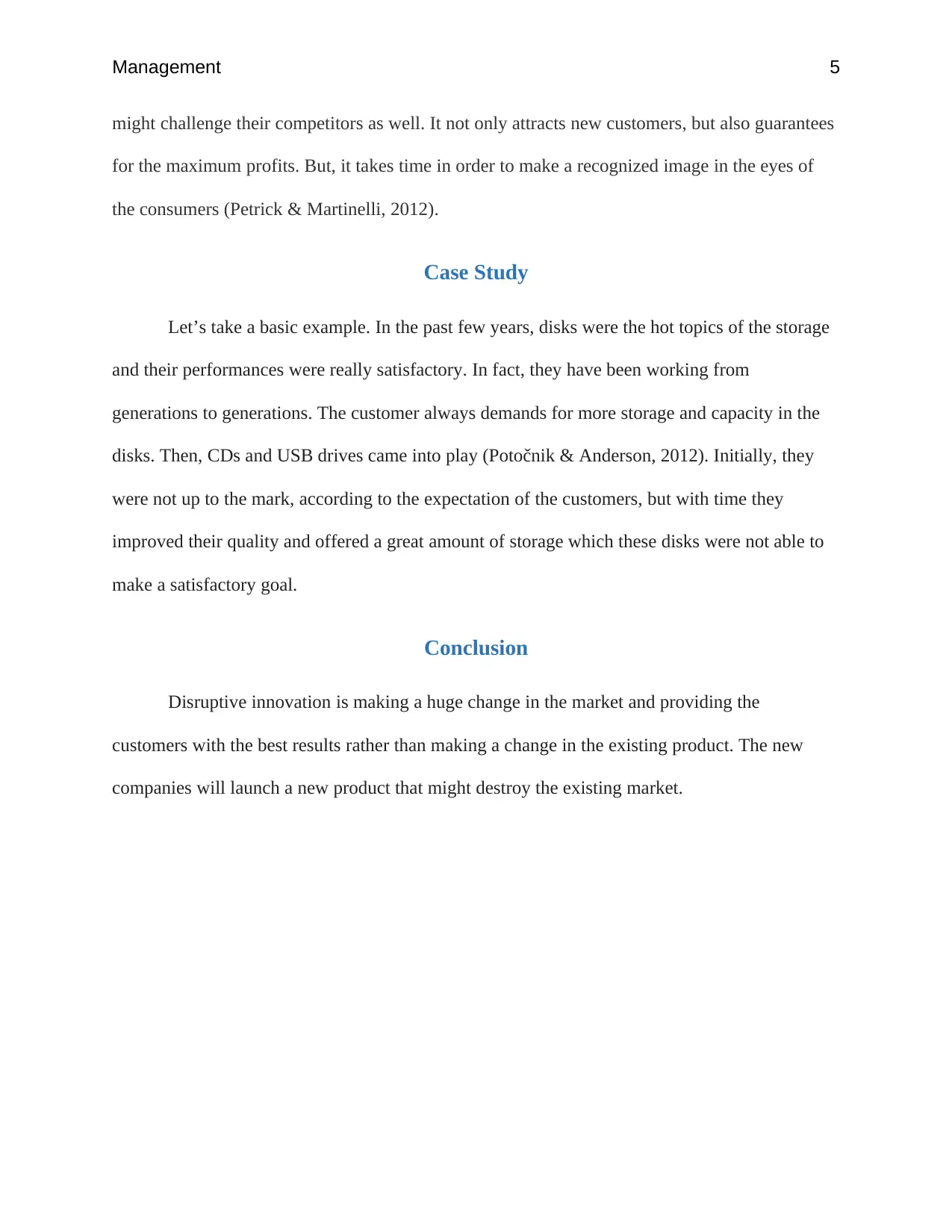
Management 5
might challenge their competitors as well. It not only attracts new customers, but also guarantees
for the maximum profits. But, it takes time in order to make a recognized image in the eyes of
the consumers (Petrick & Martinelli, 2012).
Case Study
Let’s take a basic example. In the past few years, disks were the hot topics of the storage
and their performances were really satisfactory. In fact, they have been working from
generations to generations. The customer always demands for more storage and capacity in the
disks. Then, CDs and USB drives came into play (Potočnik & Anderson, 2012). Initially, they
were not up to the mark, according to the expectation of the customers, but with time they
improved their quality and offered a great amount of storage which these disks were not able to
make a satisfactory goal.
Conclusion
Disruptive innovation is making a huge change in the market and providing the
customers with the best results rather than making a change in the existing product. The new
companies will launch a new product that might destroy the existing market.
might challenge their competitors as well. It not only attracts new customers, but also guarantees
for the maximum profits. But, it takes time in order to make a recognized image in the eyes of
the consumers (Petrick & Martinelli, 2012).
Case Study
Let’s take a basic example. In the past few years, disks were the hot topics of the storage
and their performances were really satisfactory. In fact, they have been working from
generations to generations. The customer always demands for more storage and capacity in the
disks. Then, CDs and USB drives came into play (Potočnik & Anderson, 2012). Initially, they
were not up to the mark, according to the expectation of the customers, but with time they
improved their quality and offered a great amount of storage which these disks were not able to
make a satisfactory goal.
Conclusion
Disruptive innovation is making a huge change in the market and providing the
customers with the best results rather than making a change in the existing product. The new
companies will launch a new product that might destroy the existing market.
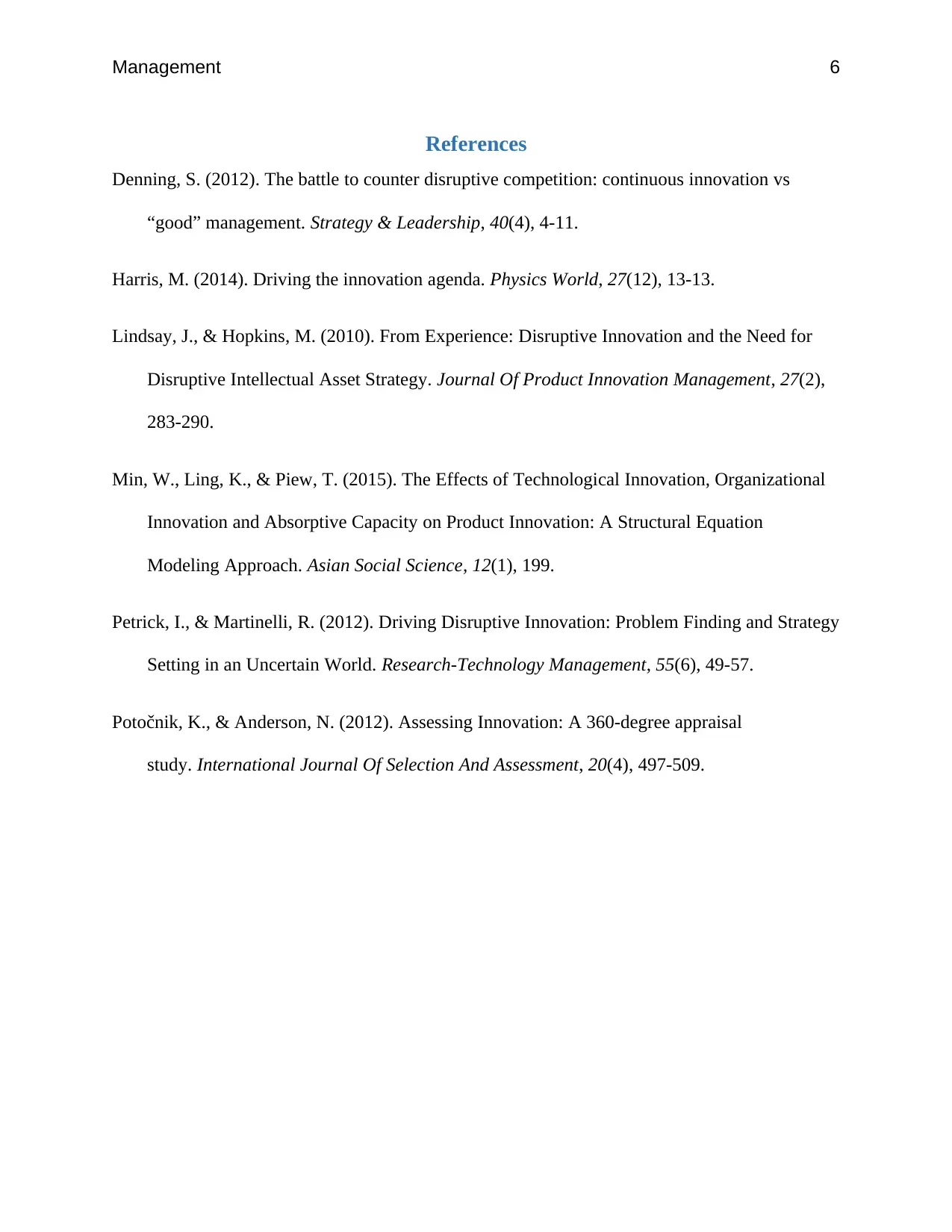
Management 6
References
Denning, S. (2012). The battle to counter disruptive competition: continuous innovation vs
“good” management. Strategy & Leadership, 40(4), 4-11.
Harris, M. (2014). Driving the innovation agenda. Physics World, 27(12), 13-13.
Lindsay, J., & Hopkins, M. (2010). From Experience: Disruptive Innovation and the Need for
Disruptive Intellectual Asset Strategy. Journal Of Product Innovation Management, 27(2),
283-290.
Min, W., Ling, K., & Piew, T. (2015). The Effects of Technological Innovation, Organizational
Innovation and Absorptive Capacity on Product Innovation: A Structural Equation
Modeling Approach. Asian Social Science, 12(1), 199.
Petrick, I., & Martinelli, R. (2012). Driving Disruptive Innovation: Problem Finding and Strategy
Setting in an Uncertain World. Research-Technology Management, 55(6), 49-57.
Potočnik, K., & Anderson, N. (2012). Assessing Innovation: A 360-degree appraisal
study. International Journal Of Selection And Assessment, 20(4), 497-509.
References
Denning, S. (2012). The battle to counter disruptive competition: continuous innovation vs
“good” management. Strategy & Leadership, 40(4), 4-11.
Harris, M. (2014). Driving the innovation agenda. Physics World, 27(12), 13-13.
Lindsay, J., & Hopkins, M. (2010). From Experience: Disruptive Innovation and the Need for
Disruptive Intellectual Asset Strategy. Journal Of Product Innovation Management, 27(2),
283-290.
Min, W., Ling, K., & Piew, T. (2015). The Effects of Technological Innovation, Organizational
Innovation and Absorptive Capacity on Product Innovation: A Structural Equation
Modeling Approach. Asian Social Science, 12(1), 199.
Petrick, I., & Martinelli, R. (2012). Driving Disruptive Innovation: Problem Finding and Strategy
Setting in an Uncertain World. Research-Technology Management, 55(6), 49-57.
Potočnik, K., & Anderson, N. (2012). Assessing Innovation: A 360-degree appraisal
study. International Journal Of Selection And Assessment, 20(4), 497-509.
1 out of 6
Related Documents
Your All-in-One AI-Powered Toolkit for Academic Success.
+13062052269
info@desklib.com
Available 24*7 on WhatsApp / Email
![[object Object]](/_next/static/media/star-bottom.7253800d.svg)
Unlock your academic potential
© 2024 | Zucol Services PVT LTD | All rights reserved.





